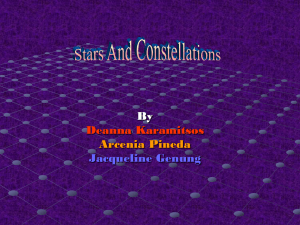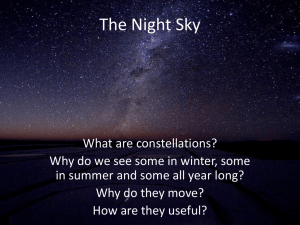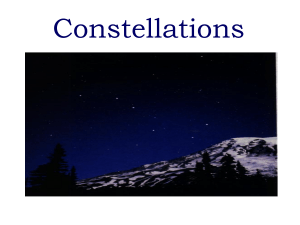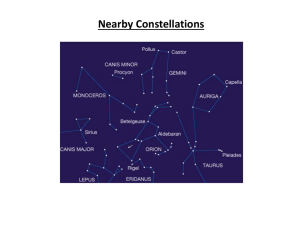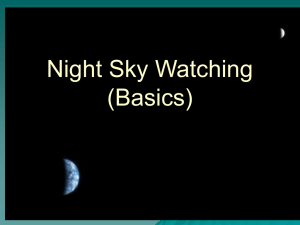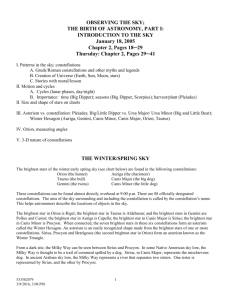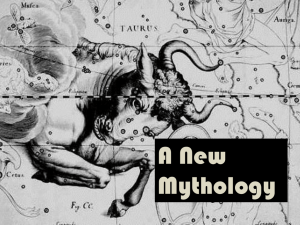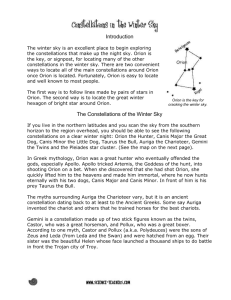Stars, Constellations, and Quasars
advertisement
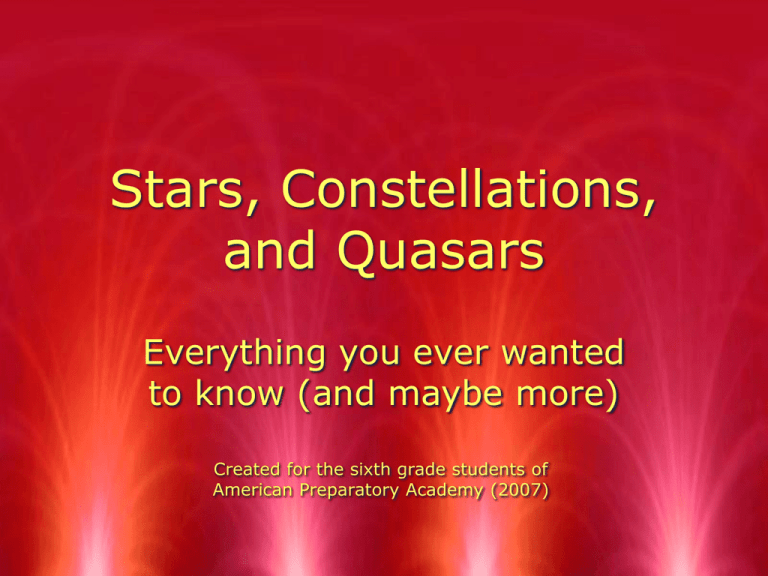
Stars, Constellations, and Quasars Everything you ever wanted to know (and maybe more) Created for the sixth grade students of American Preparatory Academy (2007) Movement of Stars Earth orbits the Sun in about 365¼ days. During this orbit Earth rotates like a spinning top with its axis always pointing in the same direction. On or around June 21 the north pole is most tilted toward the Sun. This point in Earth’s orbit is the northern hemisphere’s summer solstice. On that day the Sun is directly above the Tropic of Cancer (23½° north latitude). Movement of Stars Six months later, around December 21, the north pole is tilted away from the Sun to its greatest extent. This is the northern hemisphere’s winter solstice, and the Sun is directly above the Tropic of Capricorn (23½° south latitude) Movement of Stars Equinoxes occur midway between the two solstices. The autumnal equinox occurs around September 22, and the vernal (Latin for “spring”) equinox occurs around March 21. On the equinoxes, there are 12 hours of daylight and 12 hours of darkness at every location on Earth. This is because the Earth’s axis points neither toward nor away from the Sun. The Sun is directly overhead at the equator during equinoxes. Movement of Stars Solstices and equinoxes mark the beginnings of the seasons. Because the northern hemisphere is tilted away from the Sun when the southern hemisphere is tilted toward it (and vice versa), these hemispheres have opposite seasons. It is winter in the northern hemisphere when it is summer in the southern hemisphere, and it is spring in the northern hemisphere when it is fall in the southern hemisphere. Movement of Stars Sidereal time (star time) is determined by the movement of stars across the upper meridian Constellations Constellations are visual groupings of stars Examples: Big Dipper, Orion, Little Bear Constellations Virtually every ancient civilization observed and studied the nighttime sky, and archaeological evidence such as Stonehenge points to these early studies of astronomy. Ancient cultures also developed elaborate mythologies around stars and constellations and gave them names, some of which are still in use today. Constellations There are about 6,000 stars visible to the unaided human eye. Because we see only half the sky, there are only about 3,000 stars visible at any one time. To help locate stars, astronomers use a star map that divides the sky into 88 sectors named for a constellation within each sector. Constellations Constellations Some constellations and stars are very familiar. These include Ursa Major (the Great Bear), which includes the Big Dipper, and Ursa Minor (the Little Bear), which includes the Little Dipper. Polaris, which is also known as the North Star or the Pole Star, is an important star in the handle of Ursa Minor. Polaris takes its name from the fact that Earth’s rotational axis (north pole) points toward that star. Constellations Ursa Major (the Great Bear) including the Big Dipper Constellations Ursa Minor (the Little Bear) including the Little Dipper and Polaris (the North Star) Constellations Other constellations that are easy to identify are Canis Major; Canis Minor; Orion in the winter and spring; and Cygnus, Lyra, and Aquila in summer and fall. These constellations include the brightest stars in the sky. Constellations Canis Major Constellations Canis Minor Constellations Orion Orion’s Belt Constellations Can you find Cygnus, Lyra, and Aquila? And my personal favorite - Camelopardalis Quasars Artist's impression of quasar GB1508 with Chandra x-ray image from NASA Quasars QUASi-stellAR radio source extremely bright and distant active galactic nucleus compact halo of matter surrounding the central supermassive black hole of a young galaxy Quasar as photographed by Hubble Do you have any questions? Have a beautiful day! Then, look at the stars tonight! Bibliography http://imagine.gsfc.nasa.gov/Images/news/gb1508_xray_illustration.jpg Core Knowledge Sequence, p. 153, ISBN: 1-890517-20-8 https://www.cdis.missouri.edu/exec/data/courses2/6412/lesson01.htm http://images.google.com/imgres?imgurl=http://csep10.phys.utk.edu/astr161/lect/time/star maplarge.gif&imgrefurl=http://daintonben.stumbleupon.com/&h=900&w=991&sz=25&tbnid=Sm QWD8oD_1ZoPM:&tbnh=135&tbnw=149&prev=/images%3Fq%3Dstar%2Bmap%26um%3D1 &start=1&sa=X&oi=images&ct=image&cd=1 www.lindahall.org/.../websize/maps/0020021w.jpg http://www.lynchandthestars.com/images/starmap.jpg Google Image Search: Ursa Major, Ursa Minor, Canis Major, Canis Minor, Orion, Cygnus, Lyra, Aquila
